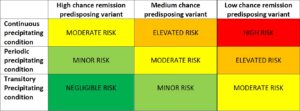Article No 300
4 December 2019
In Part 1 the 95 year journey for aHUS to become in common use to describe our disease was sketched.
The name has always had the problem that it was intended to cover all TMAs other than those of e.coli HUS and TTP. By being so vague and broad based it has not been specific enough to aid diagnosis and treatment of what is actually happening.
aHUS in its narrowest sense is seen as something caused by a triggering of uncontrolled Complement resulting from genetic defects in one or more components of the alternative pathway of Complement and which would be treatable with eculizumab for life.
Yet the aHUS patient community includes those who have had multiple triggering hits , others with non complement mutations or no complement genetic mutations at all. It includes those who have not been treated with eculizumab, or have only had temporary need for it.
So aHUS is probably somewhere between the narrow and the broader definitions. Just TMA is a common factor. The nature of the susceptibility factors and the triggering events will shape what it could be specifically.
Some time ago the alliance proposed a classification of aHUS based on the riskiness of susceptibility factors and longevity of triggering hits. And colour coded the likelihood of going into and remaining in remission following treatment . See below.

The assumption underpinning this matrix is that only genetic susceptible individuals would have aHUS and no place is allotted for idiopathic / no predisposing variant aHUS. Idiopathic can mean that no mutation has been found yet , as well as there being no mutation at all. So either a new column to the left of “high chance remission” column is needed or idiopathic should be just absorbed in to that column. Most research into idiopathic aHUS patients suggests they would fall into the“ high chance remission” but that is not conclusive.
Whilst this might help define some kind of “seriousness” of the disease, it does not clarify which TMA patients would be included into a “new aHUS” .
Complement variant mediated TMA is at the core of both aHUS and “new aHUS” .
In part 3 an attempt will be made to determine which other TMAs might be embraced by the ”new aHUS”.

